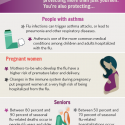Asthma medicine and you

Finding the best ways to control your asthma
Managing your asthma can be a challenge, so it’s important to have a strategy. Key factors include learning more about the condition, creating an asthma action plan with your doctor, working to stay healthy, and reducing your asthma triggers. Taking your asthma medicine as prescribed is the best way to limit your symptoms.
Finding the best asthma medicine for you
There are several medicines that work well to treat asthma. That is why it’s important to work with your doctor to find the medicine that is right for you. This will be based on your needs and symptoms.
The great news? Once you find the right medicine, you should be able to breathe better. You should also have fewer asthma symptoms and be able to do more of the things you love.
What are the types of asthma medications?
The two main types of asthma medications are rescue inhalers and controller medications.
Controller medications reduce swelling in your airways to prevent you from having an attack. That’s why it is important to take them even if you feel fine. These medicines can also ease symptoms (such as wheezing and coughing) and reduce the number and severity of attacks.
Common controller medications:*
- Budesonide-formoterol (Symbicort®)
- Fluticasone-salmeterol (Advair HFA®, AirDuo)
- Formoterol-mometasone (Dulera®)
- Budesonide (Pulmicort Flexhaler®)
- Fluticasone (Flovent HFA®, Flovent Diskus®)
- Mometasone (Asmanex Twisthaler®)
- Montelukast (Singulair®)
Rescue inhalers are meant to be used as needed. They provide fast relief by opening up your airways. Rescue inhalers are often used during asthma attacks and before exercise.
Taking controller medications as prescribed can help reduce your need for the rescue inhaler, but you should always keep your rescue inhaler on hand in case you need it.
Common rescue medications:*
- Albuterol (Ventolin®, ProAir®, Proventil®)
- Levalbuterol (Xopenex HFA®)
Talk to your doctor to make sure you are correctly using your medicines.
What is an asthma action plan?
The Centers for Disease Control and Prevention (CDC) recommends that everyone with asthma have an action plan. You and your doctor should create this plan together. It should include details that help you manage your asthma symptoms, such as when to take your medications and warning signs of an attack. Work with your doctor to keep your asthma action plan up to date.
How to stick to your treatment plan
Be prepared.
- Keep your controller medicine where you will remember to use it.
- Ask your doctor about getting a 90-day supply of your controller medicine.
- Take your rescue inhaler with you wherever you go.
- Visit your doctor every year for a wellness check.
- Call your doctor if your symptoms get worse or you are using your rescue inhaler more than usual.
- Get a flu shot every year.
- Ask your doctor about an asthma action plan.
- Identify and avoid your asthma triggers.
Be consistent.
- Try to use your controller medicine at the same time each day.
- Use an alarm on your phone or an app to remind you when to use your medication.
- Ask your pharmacy about getting automatic refills for your controller medicine.
- Make using your controller medicine part of your regular routine.
- Memorize the colors and the names of your inhalers to avoid confusion.
What are signs your treatment plan isn’t working for you?
- You have symptoms that are not from exercise and need to use your rescue inhaler more than two times a week.
- Your asthma wakes you up more than two nights a month.
- You are not able to do daily activities because of your asthma.
Review your asthma action plan to see if you are managing your asthma the best way possible.
Helpful resources for asthma
- Connect with a licensed pharmacist through UPMC AnywhereCare to discuss your asthma medications. Talking to a pharmacist through UPMC AnywhereCare is free for members.
- Find more asthma resources in the UPMC Health Library.
References
- Asthma and Allergy Foundation of America. Asthma Facts and Figures. Accessed Jan. 24, 2022. aafa.org/display.cfm?id=9&sub=42#_ftn18
- Centers for Disease Control and Prevention. Asthma. Accessed Jan. 24, 2022. cdc.gov/asthma/asthmadata.htm
- Global Initiative for Asthma. Global Strategy for Asthma Management and Prevention (2021 Update). 2021.
- Inhaler Error Steering Committee, Price D, Bosnic-Anticevich S, et al. Inhaler competence in asthma: common errors, barriers to use and recommended solutions. Respir Med. 2013;107(1):37-46. doi: 10.1016/j.rmed.2012.09.017
- National Heart Lung and Blood Institute. National Heart Lung and Blood Institute Publication Number 08- 5846. Guidelines for the Diagnosis and Management of Asthma. Accessed Jan. 24, 2022. nhlbi.nih.gov/files/docs/guidelines/asthsumm.pdf
- Sleath B, Carpenter DM, Walsh KE, et al. Factors associated with adolescent and caregiver reported problems in using asthma medications. J Asthma. 2019;56(4):451-457. doi: 10.1080/02770903.2018.1466312
- World Health Organization. Asthma fact sheet. Accessed Jan. 24, 2022. who.int/news-room/fact-sheets/detail/asthma.
*This list of medications is not complete. Follow your provider’s recommendations on the best asthma treatment for you.



